5细胞因子
免疫5-细胞因子
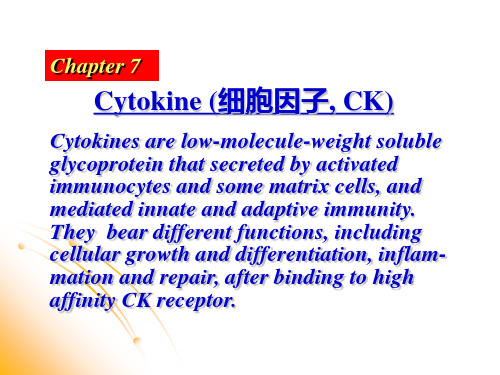
干扰素的种类及生物学素:IFN-β II型干扰素:IFN-
浆细胞样DC, LC, Mφ
成纤维C, 病毒感染C
Ta和NK细胞
抗病毒/抗肿瘤(较强) 免疫调节(较弱),MHC↑ 抗病毒/抗肿瘤(较强) 免疫调节(较弱),MHC↑ 抗病毒和抗肿瘤(较弱) 免疫调节(较强),MHC↑
附:几种重要的IL及其作用
IL-26:T细胞产生,诱导支气管上皮C分泌IL-6,IL-8, 上调ICAM-1
IL-27:IL-12亚基相关蛋白EBI13及P35相关蛋白P28 组成; 引起初始CD4+T增殖,与IL-12诱导初始 CD4+T 产生IFN-γ
IL-28:保护细胞抵抗病毒感染,但无抗病毒增殖活性 IL-29:保护细胞抵抗病毒感染,但无抗病毒增殖活性 IL-30:IL-27亚基P28的新名称 IL-31:促进造血干细胞存活,参与皮肤炎症 IL-32:T/NK/上皮细胞 ,刺激单核-巨噬细胞分泌
由多种细胞产生的可介导白细胞或免疫细胞间 相互作用,发挥免疫调节功能的细胞因子。 (一)产生细胞: 淋巴细胞,基质细胞,内皮细胞等 (二)种 类:IL-1→IL-35 (三)作 用:介导白细胞间相互作用,调节细胞生
长分化,参与免疫应答介导炎症反应
附:几种重要的IL及其作用
IL-1:引起发热, 促进T、B细胞增殖分化 IL-2:T细胞生长因子,增强NK/LAK细胞的杀伤活性 IL-3:刺激骨髓多能干细胞的增殖分化 IL-4:促进B细胞增殖分化, 诱导Ig类别转换, 产生IgE
➢细胞因子受体 膜结合型:跨膜蛋白(胞膜外区/跨膜区/胞浆区) 可溶性CK-R:可作为相应细胞因子的运载体与 受体竞争配体起抑制作用。 细胞表面的CK-R组成与相应细胞因子的共 同作用决定细胞的最终行为。
5 细胞因子

IL-11
IL-12
IL-13
1.7
名称 IL-14
曾用名
产生细胞 活化T细胞 T细胞等多种 细胞
Mr(104)
主要生物学作用 1.刺激B细胞增殖;2.抑制丝裂原诱生Ig 类似IL-2功能:1.刺激T细胞增殖;2.诱导 T、NK、LAK细胞
IL-15
1.41.5
注:BAF,B细胞激活因子;BCDF,B细胞分化因子;BCDF,B细胞生长因子; BSF-1,B细胞刺激因子-1;CDF,杀伤T细胞分化因子;CTMF,T杀伤细胞 成熟因子;CSIF,细胞因子合成抑制因子;EDF,嗜酸性粒细胞分化因子; EP,内源性致热原;Eo,嗜酸性粒细胞;HPGF,杂交瘤浆细胞瘤生长因子; HSF,肝细胞刺激因子;KHF,杀伤细胞辅助因子;LAF,淋巴细胞激活因 子;LCF,淋巴细胞趋化因子:multi-CSF,多克隆集落刺激因子;NAP-1, 中性粒细胞活化蛋白;NKSF,NK刺激因子;TCGF,T细胞生长因子。
细胞因子的网络性
细胞因子的产生、生物学作用、受体表达、相互调节 等均具有网络特点,具体表现在以下方面: 1、细胞因子间可相互诱生:如IL-1能诱生IFN-α/β、 IL-1、IL-2、IL-4、IL-5、IL-6、IL-8等多种细胞因子, 由此形成一种级联反应,表现正向或负向调节效应。 2、细胞因子受体表达的调节:如IL-1、IL-5、IL-6、 IL-11、IL-7、TNF等均能促进IL-2受体的表达;IL-1能降 低TNF受体密度;多数细胞因子对自身受体的表达呈负调节, 对其他细胞因子受体表达呈正调节。 3、细胞因子间生物学活性的相互影响:某些细胞因子 对特定生物学效应显示协同作用,如IL-1、IL-2、IL-4、 IL-6、TNF等协同促进活化B细胞增生;低浓度IFN-γ或TNF 单独应用不能激活巨噬细胞,联合使用有显著激活作用。
5 细胞因子与疾病
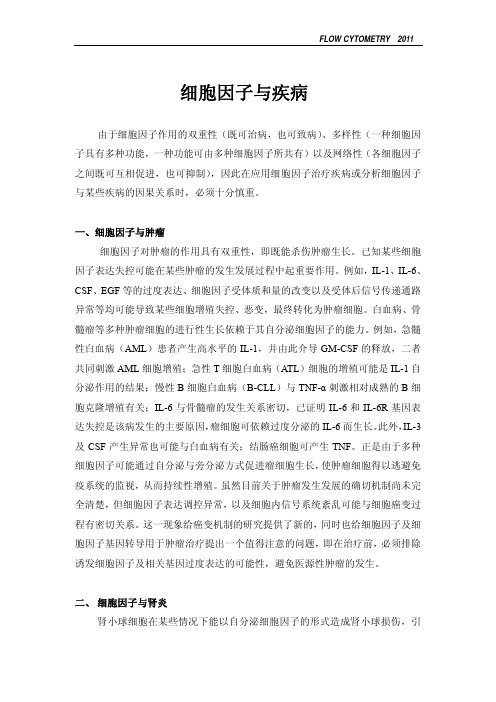
细胞因子与疾病由于细胞因子作用的双重性(既可治病,也可致病)、多样性(一种细胞因子具有多种功能,一种功能可由多种细胞因子所共有)以及网络性(各细胞因子之间既可互相促进,也可抑制),因此在应用细胞因子治疗疾病或分析细胞因子与某些疾病的因果关系时,必须十分慎重。
一、细胞因子与肿瘤细胞因子对肿瘤的作用具有双重性,即既能杀伤肿瘤生长。
已知某些细胞因子表达失控可能在某些肿瘤的发生发展过程中起重要作用。
例如,IL-1、IL-6、CSF、EGF等的过度表达、细胞因子受体质和量的改变以及受体后信号传递通路异常等均可能导致某些细胞增殖失控、恶变,最终转化为肿瘤细胞。
白血病、骨髓瘤等多种肿瘤细胞的进行性生长依赖于其自分泌细胞因子的能力。
例如,急髓性白血病(AML)患者产生高水平的IL-1,并由此介导GM-CSF的释放,二者共同刺激AML细胞增殖;急性T细胞白血病(ATL)细胞的增殖可能是IL-1自分泌作用的结果;慢性B细胞白血病(B-CLL)与TNF-α刺激相对成熟的B细胞克隆增殖有关;IL-6与骨髓瘤的发生关系密切,已证明IL-6和IL-6R基因表达失控是该病发生的主要原因,瘤细胞可依赖过度分泌的IL-6而生长。
此外,IL-3及CSF产生异常也可能与白血病有关;结肠癌细胞可产生TNF。
正是由于多种细胞因子可能通过自分泌与旁分泌方式促进瘤细胞生长,使肿瘤细胞得以逃避免疫系统的监视,从而持续性增殖。
虽然目前关于肿瘤发生发展的确切机制尚未完全清楚,但细胞因子表达调控异常,以及细胞内信号系统紊乱可能与细胞癌变过程有密切关系。
这一现象给癌变机制的研究提供了新的,同时也给细胞因子及细胞因子基因转导用于肿瘤治疗提出一个值得注意的问题,即在治疗前,必须排除诱发细胞因子及相关基因过度表达的可能性,避免医源性肿瘤的发生。
二、 细胞因子与肾炎肾小球细胞在某些情况下能以自分泌细胞因子的形式造成肾小球损伤,引起肾小球的病理变化。
例如,肾小球细胞可分泌TNF,激活肾小球内皮细胞、系膜细胞和炎症细胞,造成肾小球损害;血小板激活因子(PAF)也可作为肾小球内皮细胞、系膜细胞等的自分泌细胞因子直接或间接参与肾小球损伤;某些肾小球肾炎的发生以及肾小球系膜增生与IL-6的产生有关,在这些患者尿中IL-6的含量明显增高。
医学免疫学 5、6 细胞因子、白细胞分化抗原和黏附分子

5、6 细胞因子、白细胞分化抗原和黏附分子
1.细胞因子(CK):由参与固有免疫和适应性免疫应答的细胞合成产生,调节细胞生长、
分化成熟、功能维持和免疫应答;参与炎性反应、创伤愈合和肿瘤消长的蛋白质。
2.分化群(CD):应用以单克隆抗体鉴定为主的聚类分析方法,将来自不同实验室的识别
同一分化抗原的多种单克隆抗体归为一个分化群。
3.黏附分子(AM):是指一类能介导不同细胞间或细胞与细胞外基质间相互接触、结合和
作用的糖蛋白或糖脂分子。
细胞因子的共性:
(1)理化特性:a.分子质量低。
b.多数以单体形式存在。
c.多为单拷贝基因编码。
(2)产生特点:a.多源性、重复性。
b.瞬时性。
c.多由活化细胞产生。
(3)作用特点:a.自分泌或旁分泌。
b.高效性。
c.通过与靶细胞上相应受体结合起作用。
d.作用复杂性。
e.网络性。
f.多样性。
g.非特异性。
细胞因子12项检测解读
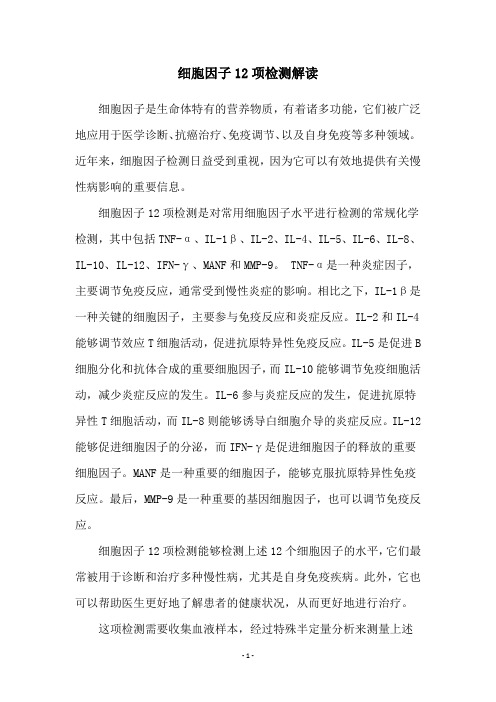
细胞因子12项检测解读细胞因子是生命体特有的营养物质,有着诸多功能,它们被广泛地应用于医学诊断、抗癌治疗、免疫调节、以及自身免疫等多种领域。
近年来,细胞因子检测日益受到重视,因为它可以有效地提供有关慢性病影响的重要信息。
细胞因子12项检测是对常用细胞因子水平进行检测的常规化学检测,其中包括TNF-α、IL-1β、IL-2、IL-4、IL-5、IL-6、IL-8、IL-10、IL-12、IFN-γ、MANF和MMP-9。
TNF-α是一种炎症因子,主要调节免疫反应,通常受到慢性炎症的影响。
相比之下,IL-1β是一种关键的细胞因子,主要参与免疫反应和炎症反应。
IL-2和IL-4能够调节效应T细胞活动,促进抗原特异性免疫反应。
IL-5是促进B 细胞分化和抗体合成的重要细胞因子,而IL-10能够调节免疫细胞活动,减少炎症反应的发生。
IL-6参与炎症反应的发生,促进抗原特异性T细胞活动,而IL-8则能够诱导白细胞介导的炎症反应。
IL-12能够促进细胞因子的分泌,而IFN-γ是促进细胞因子的释放的重要细胞因子。
MANF是一种重要的细胞因子,能够克服抗原特异性免疫反应。
最后,MMP-9是一种重要的基因细胞因子,也可以调节免疫反应。
细胞因子12项检测能够检测上述12个细胞因子的水平,它们最常被用于诊断和治疗多种慢性病,尤其是自身免疫疾病。
此外,它也可以帮助医生更好地了解患者的健康状况,从而更好地进行治疗。
这项检测需要收集血液样本,经过特殊半定量分析来测量上述12个细胞因子水平。
通常情况下,这12个细胞因子的水平可以提供多样的发病状况的信息,帮助医生确定病因并诊断和治疗疾病。
细胞因子12项检测不仅可以帮助医生了解疾病的病因,还可以更深入地了解患者的身体状况,帮助医生判断患者的疾病是否正在治疗。
例如,通过IL-2、IL-4和IL-10的水平变化,可以评估患者的炎症状况,甚至可以识别出潜在的慢性病;也可以通过IL-6和IL-8的水平变化来评估患者的免疫状态,从而给出更加有效的治疗方案。
常见的细胞因子及主要生物学作用

常见的细胞因子及主要生物学作用细胞因子是一类在细胞之间传递信号的蛋白质,它们在免疫系统、炎症反应、细胞增殖和分化等多个生物学过程中发挥重要作用。
以下是一些常见的细胞因子及其主要生物学作用:1. 白细胞介素-1(IL-1):IL-1是一种促炎细胞因子,主要参与炎症反应的调控,促进炎症细胞聚集并刺激产生更多的细胞因子。
2. 白细胞介素-2(IL-2):IL-2是一种重要的T细胞生长因子,能够刺激T细胞的增殖和分化,增强免疫应答。
3. 白细胞介素-4(IL-4):IL-4是一种辅助T细胞(Th2细胞)产生的细胞因子,主要参与B细胞分化、抗体产生和炎症反应的调节。
4. 白细胞介素-6(IL-6):IL-6是一种多功能细胞因子,能够促进B细胞产生抗体、T细胞增殖、细胞分化以及炎症反应。
5. 肿瘤坏死因子-α(TNF-α):TNF-α是一种具有多种生物学作用的细胞因子,包括诱导炎症反应、细胞凋亡、免疫调节以及促进炎症细胞聚集。
6. 转化生长因子-β(TGF-β):TGF-β是一类多功能细胞因子,主要参与细胞增殖、分化、迁移、血管生成以及纤维化等生物学过程。
7. 血小板源性生长因子(PDGF):PDGF是一类由血小板产生的生长因子,主要促进纤维细胞、平滑肌细胞和平滑肌样细胞的增殖、迁移和分化。
8. 内皮细胞生长因子(VEGF):VEGF是一类由血管内皮细胞产生的生长因子,主要调控血管生成、血管通透性以及炎症反应。
这些细胞因子在生物体内发挥关键作用,对维持正常的生理功能至关重要。
然而,细胞因子在病理条件下也可能导致疾病,如自身免疫性疾病、炎症性疾病和癌症等。
因此,深入了解细胞因子的作用机制对于研究疾病发生、发展和治疗具有重要意义。
5细胞因子
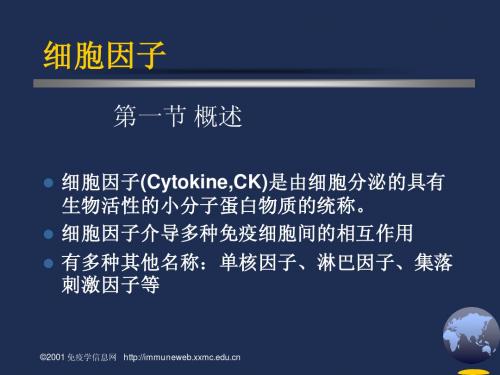
第四节 细胞因子及其相关制剂的临床应用
细胞因子与感染 感染后诱生的细胞因子既可 参与机体抗感染免疫,也能引起发热、参与急 性期反应及感染性休克 细胞因子与肿瘤 细胞因子对肿瘤的作用具有 双重性,既能杀伤肿瘤,也能促进肿瘤生长。
©2001 免疫学信息网
一种细胞可产生多种细胞因子,不同类型的细 胞也可产生一种或几种相同的细胞因子;一种 细胞因子可对多种靶细胞发挥作用,产生多种 不同的生物学效应,称多效性;几种不同的细 胞因子也可同一种靶细胞发生作用,产生相同 或相似的生物学效应,称重叠性;一种细胞因 子可以抑制另一种细胞因子的某些生物学作用, 表现为拮抗效应;可以增强另一细胞因子的某 些生物学作用表现为协同效应。
©2001 免疫学信息网
第三节 细胞因子的受体
从细胞因子结合其受体开始,到某些基因转录 的启动,要经历复杂的细胞内分子间的相互作 用,这样的作用过程称为细胞因子的信号转导 细胞因子受体都是跨膜蛋白,由胞膜外区、跨 膜区和胞浆区组成
©2001 免疫学信息网
细胞因子受体的分类 免疫球蛋白基因超家族 受体的细胞膜外区有 一个或多个免疫球蛋白样结构域。 I型细胞因子受体家族 其胞膜外区有两个不连 续的半胱氨酸残基和WSXWS基序。 II型细胞因子受体家族 其胞膜外区有四个不连 续的半胱氨酸残基。 III型细胞因子受体家族 有富含半胱氨酸的基 序。 趋化因子受体家族 G蛋白偶联受体,由7个疏 水性的跨膜区组成,和相应的配体结合后,经 偶联GTP结合蛋白而发挥生物学效应 ©2001 免疫学信息网
细胞因子的局部应用 诱导机体持续产生内源性细胞因子 细胞因子导向疗法 改进细胞因子在体内的应用方案 联合应用优 于单独用 细胞因子基因疗法
5 细胞因子
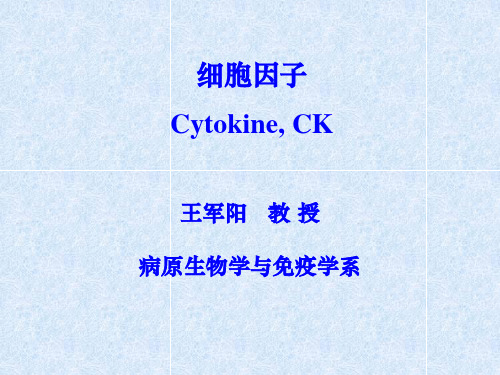
CD分子与黏附分子
Cluster of differentiation (CD) and adhesion molecule (AM)
免疫应答过程有赖于细胞间的相互作用。 作用的方式:
(1)细胞间直接接触 (2)通过分泌免疫分子如细胞因子等。 作用的分子基础: 细胞的膜表面分子
免疫细胞膜表面分子
CD抗原
应用以单克隆鉴定为主的方法,将来自不 同实验室的单克隆抗体所识别的同一分化抗 原称CD抗原 。 CD1-363
4、诱导凋亡
TNF-α和FasL可诱导靶细胞凋亡
5、促进组织修复
EGF的修复作用
五、细胞因子受体
(一)分类
1、免疫球蛋白超家族 IL-1R、IL-18R、M-CSFR等
2、红细胞生成素受体家族(I型) IL-2~7R、IL-9、11、12、13、15R、 GM-CSFR、G-CSFR、EPOR
phagocytosis, NO production
cell death
Ⅲ Naming and Classification
4. 集落刺激因子 Colony stimulating factor(CSF)
指能够刺激多能干细胞和不同发育分化 阶段的造血祖细胞分化、增殖的细胞因 子。
粒细胞集落刺激因子 (G-CSF) 巨噬细胞集落刺激因子 (M-GSF) 粒细胞-巨噬细胞集落刺激因子 (GM-CSF) 红细胞生成素(Erythropoietin , EPO) 血小板生成素(Thrombopoietin, TPO)
acting on cells secreting CKs
自分泌 autocrine
acting on neighbor cells
cxcl5指标
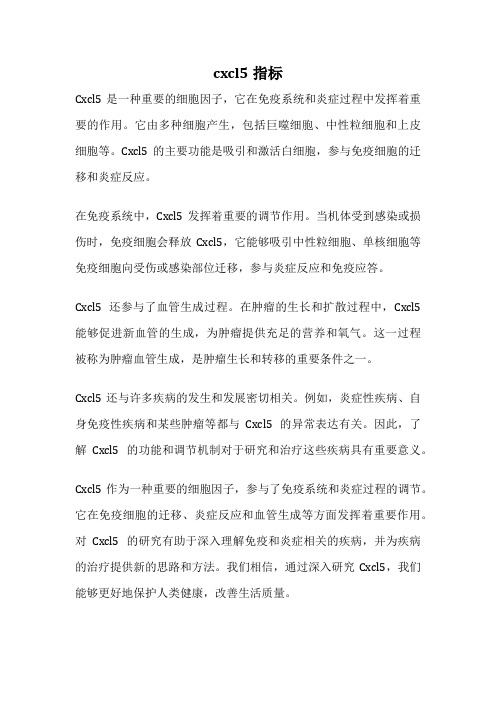
cxcl5指标
Cxcl5是一种重要的细胞因子,它在免疫系统和炎症过程中发挥着重要的作用。
它由多种细胞产生,包括巨噬细胞、中性粒细胞和上皮细胞等。
Cxcl5的主要功能是吸引和激活白细胞,参与免疫细胞的迁移和炎症反应。
在免疫系统中,Cxcl5发挥着重要的调节作用。
当机体受到感染或损伤时,免疫细胞会释放Cxcl5,它能够吸引中性粒细胞、单核细胞等免疫细胞向受伤或感染部位迁移,参与炎症反应和免疫应答。
Cxcl5还参与了血管生成过程。
在肿瘤的生长和扩散过程中,Cxcl5能够促进新血管的生成,为肿瘤提供充足的营养和氧气。
这一过程被称为肿瘤血管生成,是肿瘤生长和转移的重要条件之一。
Cxcl5还与许多疾病的发生和发展密切相关。
例如,炎症性疾病、自身免疫性疾病和某些肿瘤等都与Cxcl5的异常表达有关。
因此,了解Cxcl5的功能和调节机制对于研究和治疗这些疾病具有重要意义。
Cxcl5作为一种重要的细胞因子,参与了免疫系统和炎症过程的调节。
它在免疫细胞的迁移、炎症反应和血管生成等方面发挥着重要作用。
对Cxcl5的研究有助于深入理解免疫和炎症相关的疾病,并为疾病的治疗提供新的思路和方法。
我们相信,通过深入研究Cxcl5,我们能够更好地保护人类健康,改善生活质量。
细胞因子的种类
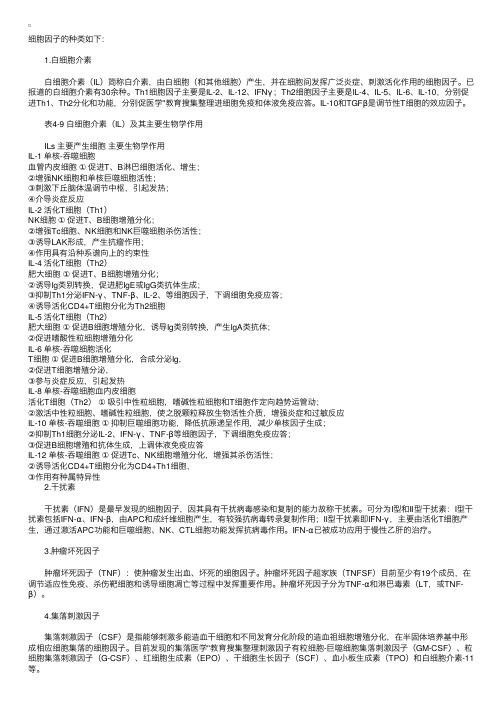
细胞因⼦的种类如下: 1.⽩细胞介素 ⽩细胞介素(IL)简称⽩介素,由⽩细胞(和其他细胞)产⽣,并在细胞间发挥⼴泛炎症、刺激活化作⽤的细胞因⼦。
已报道的⽩细胞介素有30余种。
Th1细胞因⼦主要是IL-2、IL-12、IFNγ;Th2细胞因⼦主要是IL-4、IL-5、IL-6、IL-10,分别促进Th1、Th2分化和功能,分别促医学''教育搜集整理进细胞免疫和体液免疫应答。
IL-10和TGFβ是调节性T细胞的效应因⼦。
表4-9 ⽩细胞介素(IL)及其主要⽣物学作⽤ ILs 主要产⽣细胞主要⽣物学作⽤IL-1 单核-吞噬细胞⾎管内⽪细胞①促进T、B淋巴细胞活化、增⽣;②增强NK细胞和单核巨噬细胞活性;③刺激下丘脑体温调节中枢,引起发热;④介导炎症反应IL-2 活化T细胞(Th1)NK细胞①促进T、B细胞增殖分化;②增强Tc细胞、NK细胞和NK巨噬细胞杀伤活性;③诱导LAK形成,产⽣抗瘤作⽤;④作⽤具有沿种系谱向上的约束性IL-4 活化T细胞(Th2)肥⼤细胞①促进T、B细胞增殖分化;②诱导Ig类别转换,促进肥IgE或IgG类抗体⽣成;③抑制Th1分泌IFN-γ、TNF-β、IL-2、等细胞因⼦,下调细胞免疫应答;④诱导活化CD4+T细胞分化为Th2细胞IL-5 活化T细胞(Th2)肥⼤细胞①促进B细胞增殖分化,诱导Ig类别转换,产⽣IgA类抗体;②促进嗜酸性粒细胞增殖分化IL-6 单核-吞噬细胞活化T细胞①促进B细胞增殖分化,合成分泌Ig,②促进T细胞增殖分泌,③参与炎症反应,引起发热IL-8 单核-吞噬细胞⾎内⽪细胞活化T细胞(Th2)①吸引中性粒细胞,嗜碱性粒细胞和T细胞作定向趋势运管动;②激活中性粒细胞、嗜碱性粒细胞,使之脱颗粒释放⽣物活性介质,增强炎症和过敏反应IL-10 单核-吞噬细胞①抑制巨噬细胞功能,降低抗原递呈作⽤,减少单核因⼦⽣成;②抑制Th1细胞分泌IL-2、IFN-γ、TNF-β等细胞因⼦,下调细胞免疫应答;③促进B细胞增殖和抗体⽣成,上调体液免疫应答IL-12 单核-吞噬细胞①促进Tc、NK细胞增殖分化,增强其杀伤活性;②诱导活化CD4+T细胞分化为CD4+Th1细胞,③作⽤有种属特异性 2.⼲扰素 ⼲扰素(IFN)是最早发现的细胞因⼦,因其具有⼲扰病毒感染和复制的能⼒故称⼲扰素。
常见细胞因子的临床应用

常见细胞因子的临床应用细胞因子是一类可以在细胞间相互传递信息的蛋白质,它在调节免疫反应、炎症反应、细胞生长和分化等生理过程中起着重要的作用。
在临床实践中,常见的细胞因子有许多种,它们在不同疾病的治疗中发挥着不同的作用。
本文将介绍几种常见细胞因子的临床应用。
1. 白细胞介素(IL)-2白细胞介素-2是一种免疫调节因子,可以刺激T细胞的增殖和分化,增强免疫应答。
在某些恶性肿瘤的治疗中,IL-2被用来增强免疫系统对肿瘤细胞的识别和杀伤能力,提高治疗效果。
同时,IL-2也被用于器官移植后的免疫抑制治疗,以防止移植排斥反应的发生。
2. 肿瘤坏死因子(TNF)肿瘤坏死因子是一类引起细胞凋亡和炎症反应的细胞因子。
在类风湿关节炎等自身免疫性疾病的治疗中,抗TNF药物被广泛应用。
这些药物可以抑制TNF的异常表达,减轻炎症反应,缓解疾病症状,改善患者的生活质量。
3. 白细胞介素(IL)-6白细胞介素-6是一种炎症因子,参与调节免疫反应和炎症反应的发生。
在风湿性关节炎、强直性脊柱炎等疾病中,IL-6的过度表达与疾病的发生和发展密切相关。
因此,IL-6抑制剂被用来治疗这些炎症性疾病,减轻炎症反应,缓解症状。
4. 血小板来源生长因子(PDGF)血小板来源生长因子是一种促进血管生成和修复的生长因子。
在创伤愈合和组织修复过程中,PDGF可以促进血管内皮细胞和平滑肌细胞的增殖和迁移,加速伤口愈合。
因此,PDGF被广泛应用于临床创伤外科和慢性溃疡的治疗中。
5. 白细胞介素(IL)-10白细胞介素-10是一种抗炎因子,可以抑制炎症反应和免疫应答。
在炎症性肠病、自身免疫性疾病等疾病治疗中,IL-10的应用可以减轻炎症反应,改善症状,保护组织器官免受损伤。
综上所述,不同的细胞因子在临床应用中有着不同的作用和治疗效果。
通过充分了解和利用这些细胞因子,可以更好地指导临床实践,提高疾病的治疗效果,改善患者的生活质量。
希望未来能有更多的研究和临床实践,为细胞因子在疾病治疗中的应用提供更多的可能性。
第五篇细胞因子

第五章细胞因子第一节细胞因子总论一、细胞因子的大体概念细胞因子(cytokine,CK)是指由活化免疫细胞或非免疫细胞(如骨髓或胸腺中的基质细胞,血管内皮细胞、成纤维细胞等)合成份泌的能调剂细胞生理功能、介导炎症反映、参与免疫应答和组织修复等多种生物学效应的小分子多肽,是除免疫球蛋白和补体之外的又一类分泌型免疫分子。
二、细胞因子的分类和名称依照来源,最初Dumonde(1968)将细胞因子分为淋巴因子和单核因子两类。
一、淋巴因子(lymphokine,LK)是指由活化淋巴细胞产生的能调剂白细胞和其他免疫细胞增生分化,产生免疫效应或引发炎症反映的生物活性介质。
目前已知,IL—二、3、4、五、六、九、10、1一、1二、13,TNF—β和IFN—γ等均为淋巴因子。
二、单核因子(monoline,MK)是指由单核吞噬细胞产生的能诱导淋巴细胞和其他免疫细胞活化、增生、分化、产生免疫效应和引发炎症反映的生物活性介质。
要紧包括IL—一、8,TNF—α和IFN —α等。
依照功能,目前可将细胞因子粗略分为白细胞介素(interleukin,IL)、干扰素(interferon,IFN)、集落刺激因子(colony stimulnting-factor,CSF)、肿瘤坏死因子(tumor necrosis factor,TNF)和生长因子(growth-factor,CF)五大类。
三、细胞因子受体细胞因子只有通过与靶细胞表面相应受体结合才能发挥生物学效应。
细胞因子受体与其爷膜表面受体一样,均由三个部份即膜外区(细胞因子结合区)、跨膜区(富含疏水性氨革酸区域)和胞质区(信号传导区)组成。
细胞因子受体依照胞外区氨革酸序列的同源性和结构特点,可分为四种类型。
一、免疫球蛋白超家族该家族成员胞膜外部份均具有一个或数个免疫球蛋白(Ig)样的分子构型,每一个Ig样功能区由100个左右的氨革酸组成。
IL—一、六、12受体和M—CSF受体属于这一家族。
_5-细胞因子-测验题
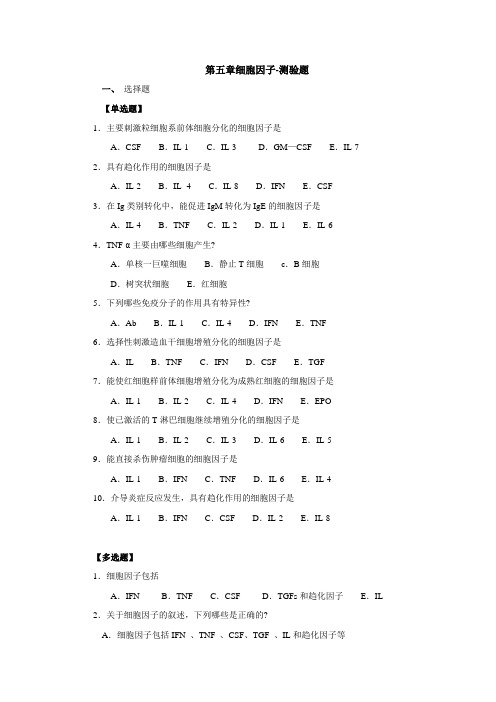
第五章细胞因子-测验题一、选择题【单选题】1.主要刺激粒细胞系前体细胞分化的细胞因子是A.CSF B.IL-1 C.IL-3 D.GM—CSF E.IL-7 2.具有趋化作用的细胞因子是A.IL-2 B.IL- 4 C.IL-8 D.IFN E.CSF3.在Ig类别转化中,能促进IgM转化为IgE的细胞因子是A.IL-4 B.TNF C.IL-2 D.IL-1 E.IL-64.TNF-α主要由哪些细胞产生?A.单核一巨噬细胞B.静止T细胞c.B细胞D.树突状细胞E.红细胞5.下列哪些免疫分子的作用具有特异性?A.Ab B.IL-1 C.IL-4 D.IFN E.TNF6.选择性刺激造血干细胞增殖分化的细胞因子是A.IL B.TNF C.IFN D.CSF E.TGF7.能使红细胞样前体细胞增殖分化为成熟红细胞的细胞因子是A.IL-1 B.IL-2 C.IL-4 D.IFN E.EPO8.使已激活的T淋巴细胞继续增殖分化的细胞因子是A.IL-1 B.IL-2 C.IL-3 D.IL-6 E.IL-59.能直接杀伤肿瘤细胞的细胞因子是A.IL-1 B.IFN C.TNF D.IL-6 E.IL-410.介导炎症反应发生,具有趋化作用的细胞因子是A.IL-1 B.IFN C.CSF D.IL-2 E.IL-8【多选题】1.细胞因子包括A.IFN B.TNF C.CSF D.TGFs和趋化因子E.IL 2.关于细胞因子的叙述,下列哪些是正确的?A.细胞因子包括IFN 、TNF 、CSF、TGF 、IL和趋化因子等B.大多数CK是由活化的细胞合成和分泌的c.细胞因子主要通过自分泌和旁分泌发挥作用D.一种细胞可产生多种细胞因子,但一种细胞因子只作用于一种细胞E.细胞因子有极强的生物学活性3.促进T、B细胞增殖分化的细胞因子是A.IL -1 B.IL -3 C.IL - 4 D.IL - 5 E.IL -64.促进肝细胞产生急性期蛋白的细胞因子是A.IL -1 B.IL -4 C.IL -6 D IFN E.TNF5.具有内源性致热原作用的细胞因子是A.TNF-αB.IL -1 C.IL -16 D.IL -12 E.IL -176.细胞因子受体的结构包括A.膜外区B.跨膜区C.稳定区D.膜内区E.可变区7.细胞因子分泌的特点是A.多细胞来源,一种CK可由不同类型细胞产生B.短暂的自限性分泌C.以自分泌方式作用于细胞本身D.以旁分泌方式作用于邻近细胞E.以内分泌方式作用于远端靶细胞【B型题】A.IL B.CSF C.IFN D.TNF E.单核因子1.由单核/巨噬细胞产生的细胞因子统称为2.能直接造成肿瘤细胞死亡的细胞因子称为3.能刺激不同的造血干细胞,并在半固体培养基中形成细胞集落的细胞因子称为4.能抵抗病毒的感染、干扰病毒复制的细胞因子称为5.能介导白细胞间相互作用的细胞因子称为【C型题】A.活化的T细胞分泌B.单核/巨噬细胞分泌C.两者均是D.两者均不是1.TNF-α主要由2.TNF-β主要由3.IL-1主要由4.IL-2主要由5.Ig是由二、翻译并解释1. cytokine(CK)2. interleukin (IL)3. interferon (IFN)4. tumor necrosis factor (TNF)5. colony stimulating factor (CSF)6. growth factor (GF)7. chemokine三、问答题1. 简述细胞因子的来源。
细胞因子受体分类

细胞因子受体分类
根据细胞因子受体膜外区的氨基酸序列,可将其主要分为三个受体
家族:
(一)造血生长因子受体家族(HPR)
大部分细胞因子如IL-2、3、4、5、6、7、9等的受体均属于这一
家族,其典型结构特点是含有Trp-Ser-X-Trp-Ser(W-S-X-W-S)的五联
保守序列,与细胞因子结合功能密切相关。
(二)lg超家族
IL-1受体、M-CSF受体等属于这一家族,IL-6受体同时含有lg超家
族和HPR家族两个结构区。
这一超家族的特点是均在膜外区含有lg样的
分子构型,每个lg样功能区由100个左右的氨基酸组成,通过二硫键形
成稳定的发夹样反平行的β片层折叠结构。
(三)干扰素受体超家族
干扰素α和β共用同一个受体,与干扰素γ受体的结构有类似之外,均含有一段200个氨基酸的保守序列,其中4个半胱氨酸是共有的。
医学免疫学课件 第五章 细胞因子
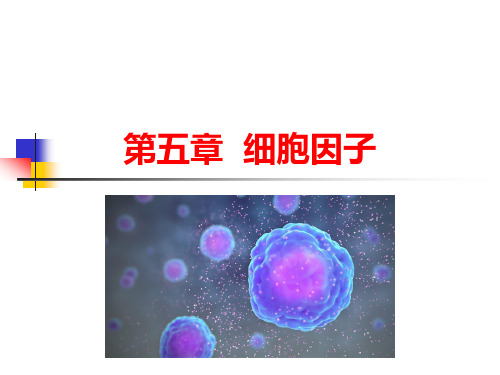
(公有γ链)
(公有β链)
(公有gp130亚单位)
第二节 细胞因子特征与作用
一、细胞因子的共同特征
✓ 多样性 一种细胞因子可作用
于多种细胞,取决于细胞 因子浓度、所作用靶细胞 的类型、微环境中其它细 胞因子等条件,可产生多 种生物学作用。
✓ 参与免疫细胞的分化和发育 ✓ 参与适应性免疫应答和免疫调节 ✓ 参与固有免疫和炎症反应
(一)参与免疫细胞的分化和发育
(二)参与适应性免疫应答和免疫调节
调节特异性免疫应答
细胞因子在Ig类别转换中的作用
细胞因子对Th1和Th2细胞的调节作用
(三)参与固有免疫和炎症反应
✓ 参与固有免疫
• 促进NK细胞的杀伤活性:IL-2、IL-12等; • 增强单核/巨噬细胞的吞噬和杀伤功能:IFN-γ、
CSF) ✓ 生长因子(growth factor,GF) ✓ 趋化因子(chemokine)
1. 白细胞介素(Interleukin,IL)
✓ 最初是指由白细胞产生并介导白细胞间相互 作 用的细胞因子;后定义为由多种细胞产生并作 用于多种细胞的一类细胞因子。
✓ 前至少发现38种,IL-1...IL-38。
TNF、IL-1β等; • 抗病毒、抗肿瘤:IFN-α/β、TNF等。
✓ 参与炎症反应
• TNF-α、IL-1、IL-6、IFN-γ和趋化因子等促炎细 胞因子可直接或间接参与炎症反应,利于机体抑 制和清除病原体,但也可介导病理性损伤。
“细胞因子风暴” (Cytokine storm)
✓ 此外,还可促进Th2 分化,抑制Th1和巨 噬细胞功能。
十二项细胞因子对照表

以下是十二项细胞因子的对照表,包括旧参考范围和新参考范围,单位为pg/ml:
1.白细胞介素17(IL-17):0-20.60 pg/ml(旧)与0-20.60 pg/ml
(新)
2.白细胞介素12p70(IL-12p70):0-
3.40 pg/ml(旧)与0-3.20
pg/ml(新)
3.白细胞介素10(IL-10):0-
4.91 pg/ml(旧)与0-
5.90 pg/ml(新)
4.白细胞介素8(IL-8):0-53.09 pg/ml(旧)与0-21.40 pg/ml(新)
5.白细胞介素6(IL-6):0-5.30 pg/ml(旧)与0-20.00 pg/ml(新)
6.白细胞介素5(IL-5):0-3.10 pg/ml(旧)与0-3.40 pg/ml(新)
7.白细胞介素4(IL-4):0-3.00 pg/ml(旧)与0-12.90 pg/ml(新)
8.白细胞介素2(IL-2):0-5.71 pg/ml(旧)与0-11.40 pg/ml(新)
9.白细胞介素1β(IL-1β):0-12.40 pg/ml(旧)与0-12.10 pg/ml
(新)
10.干扰素α(IFN-α):0-8.50 pg/ml(旧)与0-7.90 pg/ml(新)
11.干扰素γ(IFN-γ):0-7.42 pg/ml(旧)与0-17.30 pg/ml(新)
12.肿瘤坏死因子α(TNF-α):0-4.60 pg/ml(旧)与0-5.50
pg/ml(新)。
细胞因子有哪些

细胞因子有哪些细胞因子是一类可以促进或抑制细胞增殖、分化、功能调节以及机体免疫应答的生物活性蛋白质。
它们在维持细胞内外的相互作用和信号传导中起着关键的调控作用。
细胞因子广泛存在于动物和植物体内,包括内源性和外源性细胞因子。
下面将对主要的细胞因子进行介绍。
1. 白细胞介素(Interleukins,简称IL):白细胞介素是一类在细胞间传递信号、促进细胞增殖、分化和调节免疫应答的细胞因子。
常见的白细胞介素有IL-1、IL-2、IL-4、IL-6、IL-10等。
它们在炎症反应、免疫应答和组织修复中发挥重要作用。
2. 肿瘤坏死因子(Tumor Necrosis Factors,简称TNF):肿瘤坏死因子是一类促成细胞凋亡的细胞因子,可以通过调节细胞增殖、凋亡、炎症反应等去调节机体内环境。
主要成员有TNF-α和TNF-β,它们在免疫、炎症和恶性肿瘤的发生发展等方面发挥着重要作用。
3. 干扰素(Interferons,简称IFN):干扰素是一类具有抗病毒、抗肿瘤、免疫调节和抑制细胞增殖等效应的细胞因子。
常见的干扰素有IFN-α、IFN-β和IFN-γ,它们在抵抗病毒感染、调节免疫应答等方面起重要作用。
4. 生长因子(Growth Factors):生长因子是一类通过与细胞膜受体结合来促进细胞增殖与分化的细胞因子。
常见的生长因子有表皮生长因子(EGF)、成纤维细胞生长因子(FGF)、血小板衍生生长因子(PDGF)、神经生长因子(NGF)等,它们在胚胎发育、伤口愈合和组织修复等过程中起着重要作用。
5. 补体系统(Complement System):补体系统是一类在细胞间调节免疫应答和炎症反应的细胞因子,包括补体蛋白和相关因子。
补体系统通过多个级联反应参与机体对抗病原微生物、清除免疫复合物和调节炎症反应等。
除了上述主要的细胞因子外,还有许多其他细胞因子如肿瘤生长因子(TGF)、趋化因子(Chemokines)、炎症介质等。
5 细胞因子

表1
名称
IFNIFN-α IFNIFN-β IFNIFN-γ
干扰素
受体
CD118 CD118
氨基酸数
166 166
产生细胞
白细胞 成纤维细胞
功能
抗病毒,促进MHC I类分子 抗病毒,促进MHC I类分子 的表达 抗病毒,促进MHCI类分子 抗病毒,促进MHCI类分子 的表达
143
CD119
激活巨噬细胞,促进MHC 激活巨噬细胞,促进MHC T细胞、NK细胞 分子表达和抗原提呈,抑制 细胞、NK细胞 分子表达和抗原提呈, Th2细胞 Th2细胞
(四)IL(四)IL-6 1. 细胞来源
主要由单核巨噬细胞、 Th2细胞、 Th2细胞、 血管内皮细胞、成纤维细胞产生。
2. 主要功能 (1)刺激活化B细胞增殖,分泌抗体; (2)刺激T细胞增殖及CTL活化; )刺激T细胞增殖及CTL活化; (3)刺激肝细胞合成急性期蛋白,参与炎症反应; (4)促进血细胞发育。
(二)主要生物学活性 1. Ⅰ型干扰素
(1)抗病毒和抗肿瘤 ① 诱导宿主细胞产生抗病毒蛋白,干扰病毒复制; ② 增强NK细胞对病毒感染细胞和肿瘤细胞杀伤; 增强NK细胞对病毒感染细胞和肿瘤细胞杀伤; ③ 促进MHC-Ⅰ类分子表达,增强CTL对病毒感染 促进MHC- 类分子表达,增强CTL对病毒感染 细胞和肿瘤等靶细胞的杀伤。 (2)免疫调节: 与Ⅱ型干扰素类似。
第二节
白细胞介素 干扰素 肿瘤坏死因子 集落刺激因子 趋化因子 生长因子
细胞因子的种类与功能
interleukins,IL , interferon,IFN , tumor necrosis factor,TNF , Colony - stimulating factor,CSF , chemokines growth factor,GF ,
- 1、下载文档前请自行甄别文档内容的完整性,平台不提供额外的编辑、内容补充、找答案等附加服务。
- 2、"仅部分预览"的文档,不可在线预览部分如存在完整性等问题,可反馈申请退款(可完整预览的文档不适用该条件!)。
- 3、如文档侵犯您的权益,请联系客服反馈,我们会尽快为您处理(人工客服工作时间:9:00-18:30)。
第一节 细胞因子的概念和特点
• 一、细胞因子的概念 • What are cytokines? • A collection of polypeptides used for communications between cells
– Play role similar to hormones (messengers of the endocrine system) – Hormones usually act at a distance
• Endocrine
– Cytokine binds cells in distant parts of the body
Cytokine Actions
• Pleiotropy
– Act on more than one cell type (INFa/b)
• Redundancy
– More than one cytokine can do the same thing (IFNa/b and IFNg)
克隆刺激因子(colony stimulating actor,CSF)
五、趋化因子
• 趋化因子(chemokine)-来源于英文chemoattractant cytokine,故又称趋化性细胞因子,是一类对不同靶细 胞具有趋化效应的细胞因子家族,已发现50多个成员。 根据分子氨基酸端半胱氨基酸残基的数目和间隔分类: • ㈠ CC亚家族 • – MCP、RANTES(趋化中性粒细胞以外的白细 胞) • ㈡ CXC亚家族 – IL-8(趋化、激活中性粒细胞) • ㈢ C亚家族 • ㈣ CX3C亚家族
• Cytokines regulate the immune response
– Cells with the appropriate receptors become activated – To differentiate – To express receptors which will make them receptive to other cytokines – To secrete other cytokines
四、具有造血生长活性的细胞因子
集落刺激因子(colony stimulating factor,CSF) • 1. IL-3 • 2. 促红细胞生成素(erythro protein,EPO) • 3. 促血小板生成素(thrombopoietin,TPO) • 4. 干细胞因子(stem cell factor,SCF) • 5. 白血病抑制因子(leukemia inhibitory factor,LIF) • 6. IL-11
How do cytokines tell cells what to do?
• Produced by cells as part of normal cellular activity and/or the result of environmental trigger • Bind to receptors on cells • Trigger signal transduction pathways • Initiate synthesis of new proteins
⑵细胞因子的共同特点: ①分子量低,属糖蛋白; ②以自分泌或旁分泌形式在局部发挥作用; ③具有激素样活性,作用迅速而短暂; 通 过和受体结合,对免疫细胞功能进行正 负调节
Autocrine and paracrine
第二节 细胞因子分类和生物学活性
细胞因子分类按照主要生物活性进行分类 ①白细胞介素(interlukin,IL) -免疫调节作用 ②干扰素(interferon,IFN)-抗病毒作用 ③肿瘤坏死因子(tumor necrosis factor,TNF)抗肿瘤活性和炎症介质 ④集落刺激因子(colony stimulating factor,CSF) -刺激骨髓造血前体细胞生长分化 ⑤趋化因子(chemokine)-趋化免疫细胞 ⑥生长因子(growth factor,GF)
Cytokines can act in three different manners
• Autocrine
– Cytokine binds to receptor on cell that secreted it
• Paracrine
– Cytokine binds to receptors on near by cells
一、具有免疫调节作用的细胞因子
• 包括白细胞介素和β转化生长因子(TGF β ) • 白细胞介素是指一类具有重要免疫调节作用的细胞因 子,包括单核细胞因子(monokine)和淋巴因子 (lymphokine)。 ㈠促进细胞免疫 –IL-1、IL-2、IL12、IL15 ㈡促进体液免疫 –IL-2、IL-4、IL-5、IL-6、IL-10、IL13 ㈢刺激骨髓造血前体细胞生长和分化 –IL-3、IL-7、IL11 ㈣参与炎症反应 – IL-1、IL-6、IL-8、IL-16
具有免疫调节作用的细胞因子
• IL-1
IL-2
IL-3、IL-5(CSF)
IL-4
IL-6
IL-8
IL-10
IL-12
二、具有抗病毒活性的细胞因子
• • • • • • • • • 干扰素(interferon,IFN) IFN α –白细胞产生,抗病毒功能﹥免疫调节功能 IFN β –成纤维细胞产生,抗病毒功能﹥免疫调节功能 IFN γ –活化T细胞产生,免疫调节功能﹥抗病毒功能 生物学功能: ㈠抑制病毒增殖 ㈡增强MHC分子表达 ㈢增强NK、CTL、MΦ活性 ㈣抑制肿瘤细胞分裂
六、生长因子
• 生长因子(growth factor,GF)是一类具有刺 激细胞生长功能的细胞因子。 • ①转化生长因子(TGF- β ) • ②表皮细胞生长因子(EGF) • ③血管内皮细胞生长因子(VEGF) • ④成纤维细胞生长因子(FGF) • ⑤神经生长因子(NGF)
第三节 细胞因子受体
细胞因子作用的基本方式
• 细胞因子的效应机制涉及复杂的细胞内信号转导: • 细胞因子与相应受体结合后,诱导受体亚单位发生聚 合,引起氨酸激酶等激活,导致细胞内一系列底物磷 酸化或去磷酸化,启动不同的信号转导途径。 • 胞内信号分子所转导的信号使转录因子激活,转录因 子进入细胞核内,与特异性基因序列结合,启动基因 转录,促进或调节相应分子的合成,最终引起细胞应 答,并显示广泛的生物学效应。
一、细胞因子受体分类 1. 免疫球蛋白超家族 2. Ⅰ型细胞因子受体家族 3. Ⅱ型细胞因子受体家族 4. Ⅲ型细胞因子受体家族 5. 趋化因子受体家族
细胞因子受体分类
细胞因子受体作用方式
细胞因子受体公用亚基现象
三、可溶性细胞因子受体
1.可溶性细胞因子受体产生机理 ⑴膜细胞因子受体经蛋白酶水解后,其胞 外区从细胞表面脱落形成。 ⑵通过受体mRNA不同剪接后形成新的编 码可溶性细胞因子受体的转录子,经翻 译后从细胞内直接分泌到细胞外。
作用的复杂性
⑶网络性: • 一种细胞可以产生多种细胞因子; • 多种细胞可以产生一种细胞因子; • 不同细胞因子对同一细胞的作用可表现为相互 协同或拮抗; • 某些细胞因子可调节自身或其他细胞因子受体 表达; • 膜结合型细胞因子可转变为分泌型细胞因子; • 细胞因子的生物学活性可受其他细胞因子或某 些细胞因子拮抗物的调节
– Many cytokines have very short half-lives
• Only cells in close proximity will be activated
– High concentrations of cytokines are needed for activation – Only cells in close proximity will be activated – May require cell-to cell contact
作用的复杂性
⑷细胞因子的抑制性调节 ①天然细胞因子受体拮抗物 - 存在与正常人体内,与细 胞因子受体结合,但并不启动胞内信号转导,可竞争 性抑制细胞因子与靶细胞受体结合。 ②可溶性细胞因子受体 - 竞争性抑制细胞因子与靶细胞 的膜受体结合 ③具有负向调节作用的细胞因子:IL-4、IL-10、IL-11、 TGF ④假受体 - 某些细胞表面可表达细胞因子结合分子(假 受体,deceptor),其与细胞因子结合并不启动胞内 信号转导,不引起细胞应答。
干扰素(interferon,IFN)
干扰素IFNγ的免疫调节作用
三、具有抗肿瘤活性的细胞因子
• 肿瘤坏死因子(tumor necrosis factor,TNF) • TNF α –活化单核/巨噬细胞产生 • TNF β (lymphotoxin,LT)–活化T细胞产生 • 生物学功能: • ㈠抑制肿瘤细胞增殖 • ㈡抑制病毒感染细胞增殖 • ㈢促进TL、BL增殖 • ㈣炎症介质 • ㈤内源性致热源
• Synergy
– Two or more cytokines cooperate to produce an effect that is different or greater than the combined effect of the two cytokines when functioning separately (IL-12 and IL-8)
• Antagonism
– Two or more cytokines work against each other (IL-4 and IL12)
• How can non-specific cytokines act specifically? • Only cells expressing receptors for specific cytokines can be activated by them
